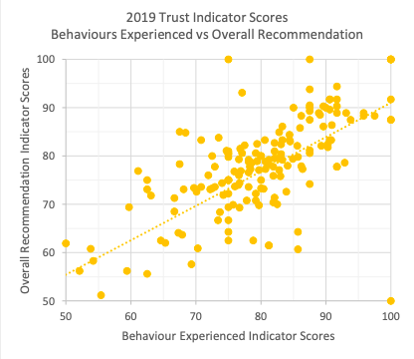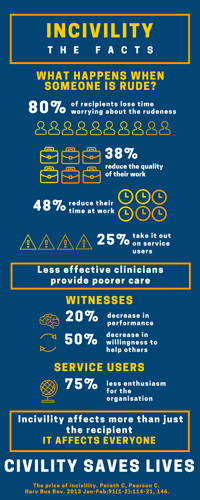Positive workplace cultures get the best out of individuals and teams.
Staff feel valued and empowered. They give more and are more effective. There is a lot of evidence on this topic but here are some take home messages:
Patient safety
- Bullying and poor workplace behaviour have a negative effect on teams, their effectiveness and patient safety and care.1,2
- In maternity care intra- or interprofessional communication have been identified as critical contributory factors to negative outcomes in several official investigations/reports.3,4,5
- Poor working relationships make staff less willing to admit mistakes or raise concerns, obstructing our ability to learn and improve and again ultimately affecting patient safety.6
- Bullying is estimated to cost the NHS £2.28 billion a year1, which is money that could be spent on delivering patient care.
- This video, from Civility Saves Lives, demonstrates the effect of incivility on patient safety.
The Team
- The recipient, bystanders and the team are all victims of workplace incivility and it impairs their cognition and clinical performance (see Civility Saves Lives infographic below).
- Bullying negatively impacts on the psychological and physical health of individuals1
- It lowers job satisfaction, increases staff turnover and increases absenteeism1
- A key reason for nurses and midwives leaving the NHS is the combination of heavy workloads and bullying and harassment at work.7
Quality of training
- Analysis of the annual Training Evaluation Form (TEF) consistently demonstrates a positive correlation between good workplace behaviours and higher quality O&G training (including a trainee’s overall recommendation of their unit).8,9
- Where O&G trainees have reported unprofessional behaviours – sadly 39% of these have been by consultants including educational supervisors. Concerningly, this is a recurring theme in the TEF report with less than 50% of trainees reporting bullying or undermining when subject to it. The most common reasons for not reporting were concern that the situation would be made worse, concern that it would affect their career progression and feeling that they would not be supported if they reported it. Of those reporting only 21% had resolution of the situation.8
- A poor working environment directly correlates to an inadequate training environment and anecdotal evidence suggests this can become learnt behaviour, propagating through the team and becoming ingrained.
Chart: 2019 Trust Indicator Scores – Behaviours experienced vs overall recommendation
Infographic: Incivility – The Facts

See this and more infographics by Civility Saves Lives at www.civilitysaveslives.com/infographics
1. Evidence synthesis on the occurrence, causes, consequences, prevention and management of bullying and harassing behaviours to inform decision making in the NHS J.C. Illing. Available at http://dro.dur.ac.uk/10533/1/10533.pdf?DDD45+DDC42+clfc44 (Accessed 6 August 2020)
2. Report of the Mid Staffordshire NHS Foundation Trust Public Inquiry, 2013
3.The report of the Morecambe Bay investigation, 2015. (Accessed 26 February 2021)
4. Each Baby Counts final report in 2020
5.First report of the independent review into maternity services at the Shrewsbury and Telford Hospital NHS Trust in 2020.
6. How incivility shuts down our brains at work – Christine Porath
7. Blog: Time for bullying and harassment within nursing and midwifery to stop – The Nursing and Midwifery Council (Accessed 26 February 2021)
8. Workplace Behaviour Report 2019 (Accessed 26 February 2021)
9. Quinn S, Frost J, Berry J, Bahl R. The impact of undermining and bullying on O&G training in the UK. BJOG 2019; 126 (S2): p33. doi.org/10.1111/1471-0528.3_15703
